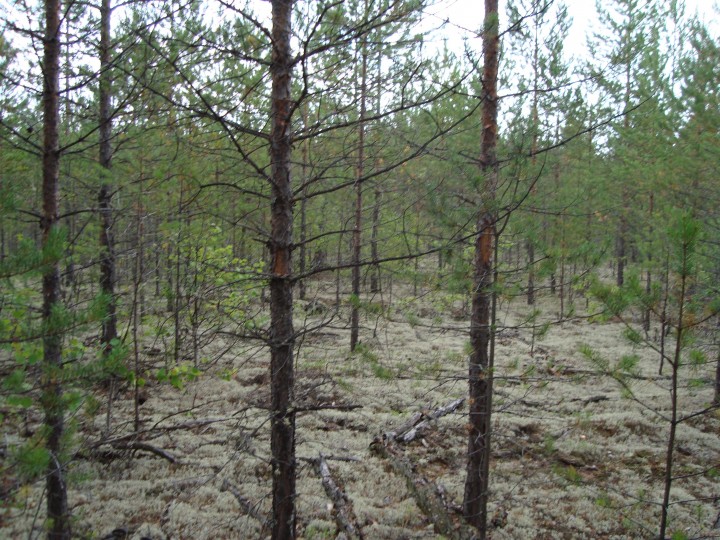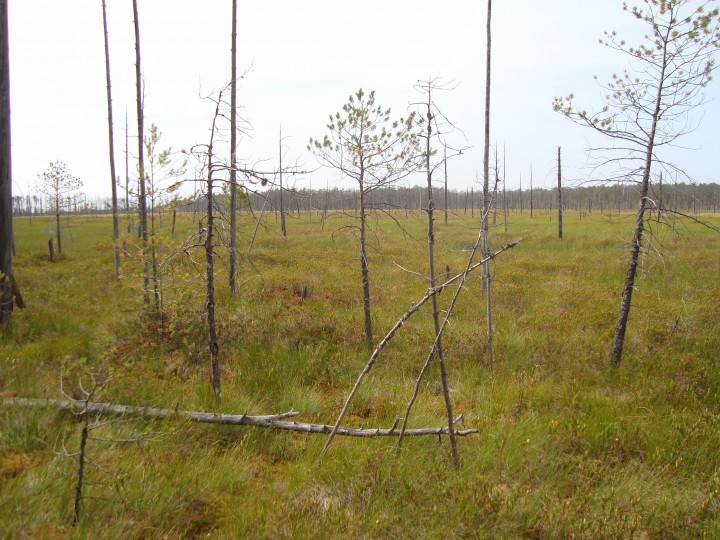Tomsk Oblast 58.55 N 85.68 E
11:00 p.m. Local Siberia; 11:00 a.m. next day EST
High 79 F Low 62 F Clear
We’ve been on the move today. Last night we looked at our data, and realized that we are done with last night’s site. We still need a day’s worth of different data, so that’s what we are doing today – chasing the data.
The site we are leaving was really productive. It was close to a lot of GLAS footprints, so we could get to a lot plots fairly quickly. And the team worked really hard to gather a tremendous amount of data in a short time. They would start early in the morning and come back late at night, pretty much exhausted. As a night cap, Ross and Bruce would look over maps and data and plan the next day’s work before bed. Pasha and Sergei were always working on logistics, keeping our camp and our instruments safe. So these guys have been putting in remarkable days here. But we have enough from that site – now we need something different.

So what do we need?
Well, here’s some background. In order to help us to understand how our LIDAR waveforms – the data from the satellite – relate to biomass on the ground, we need to validate our instrument in three different types of biomass areas: high biomass, low biomass and “no” biomass. We need to know what our instrument is telling us in each area, not just in one or two.
High biomass areas are dense forests where most trees have a high DBH (diameter at breast height) and are tall, too. Low biomass areas are more sparse forest, with smaller and shorter trees. “No” biomass areas usually do have some vegetation, maybe even some small, very scattered trees, but are essentially just open land, with scrub or grass as primary vegetation.
On this trip, we’ve accumulated a lot of low biomass and some high biomass measurements. But we have not yet gathered no-biomass measurements, and we do want to have that from this area in Siberia. So that was our quest for today – to locate areas essentially empty of measurable trees. For that, we head to bogs.
Bogs are wetlands that accumulate acidic peat from dying plants, especially mosses or lichens. You don’t usually find a lot of trees in bogs, although some species can survive with their roots in water, or, as we like to say, with wet feet.
There are a lot of bogs in this part of Siberia. In fact, the western Siberian lowlands are the world’s largest bogs, covering more than 600,000 square kilometers. In parts of Russia, the bogs have been drained so that people can use the land for houses or agriculture, or to use the land for agriculture, or to allow dried bogs to be mined for peat. Peat is used commercially as soil amendment, in aquaculture, and as fuel. Russia is the world’s leading extractor of peat for fuel, producing something like 90 million metric tons a year.
But draining the peat bogs has set up a really bad situation. This summer western Russia is experiencing record high temperatures and drought, which led to huge numbers of wildfires. Forest fires are pretty bad, but dried peat bogs can be a nightmare when they burn – and they are burning. Peat fires release a lot of smoke and carbon dioxide, causing problems for health as well as the environment. Not only that, but it it’s hard to put out a peat fire. Dry peat is like a thirsty sponge, absorbing all the water that is put on it. Meanwhile, areas under the surface stay very dry. Subterranean fires can burn for weeks or months. Sometimes a peat fire will burn underground all winter, only to ignite as a wildfire again in the spring.
This area of Siberia, however, has had plenty of rain this year and only a few hot days. So our bogs are wet and easy to find. We drove about 50 km – without car trouble – and located just the right spot to get multiple “no biomass” measurements in a short time. Well, it wasn’t quite that easy. It took the team about three hours of extremely hard work to gather their measurements.
When Slava pulled over at our work site, we decided that, although the amoxicillin is working and I’m feeling better, bogs are no a place for a sick scientist. Slava and I stayed near the vehicles, while the team walked down a logging road. They said that the moment they turned into the forest, the walk turned wet, with mud grabbing at their feet.

So why does it take so long to measure “no biomass” plots, if there is nothing to measure? Well, we’re here to verify the data the instrument gives us. Just because it indicates “no biomass” and we look across the horizon and see a bog, we can’t call that verification. It’s not science until you quantify it and measure it, objectively. So we measure no-biomass sites.
Just like anywhere else, we find the center of the GLAS footprint, and lay out our 10 m radius plot. Then we need to walk the area to make sure there is nothing of measurable size within that circle. Sometimes there may be some small stuff that needs notated or measured. And we need to make some field observations about the type of soil and ground cover. But most of all, we need to get to the center and lay out our plot. And, in a bog, just doing that can be very tiring.
I can’t remember exactly how many sites they measured today, but I know we have over 60 plots total for this trip. That is enough, and it’s amazing work for a trip that has had so many delays. If you remember, we arrived in Krasnoyarsk late, because of the fires that shut down flights through Moscow, and that took two days off our field study. Then we had delays to repair the car and a long side-track because the road to Belyy Yar was impassible. And we were short one set of hands, because I’ve been sick. Yet we’ve overcome all of this, and still gotten enough plots to make our analyses back in the lab. I cannot say enough about the hard work and good humor of these guys – Pasha, Sergei, Ross, Bruce, and Marsha – they are a tough and awesome crew.
After everyone came back from the bogs, we stowed our gear and headed off to find a camp. And we found a nice one, once again on the Ket River. The sand here is white and very fine, so it is different from the tan sand we slept on at Camp Stepanova. Slava looked at the sand closely, and he says it might reflect that this area was either an ocean or a desert at some time long past.
This area was once used as another sort of camp, and it’s been well-used. Someone heavily worked the sand and grass with a bulldozer in the past, so it’s very flat. We are right on the river, and the breeze is cool, but it keeps the mosquitoes down. It is a good camp – no roots or rocks to disturb sleep, just warm sand.
We are still missing our fish soup. Not long after we got here this evening, Sergei set up the inflatable boat and put some nets in the river, hoping to get some supper. But he caught nothing. We couldn’t catch anything with rod and reel, either. They say there are big pike in the Ket – if we could just wait until the full moon when they are wearing new teeth are new and get very hungry. In a way, I wish that we could just hang out until the full moon, but in another way, I am ready to head for home.



